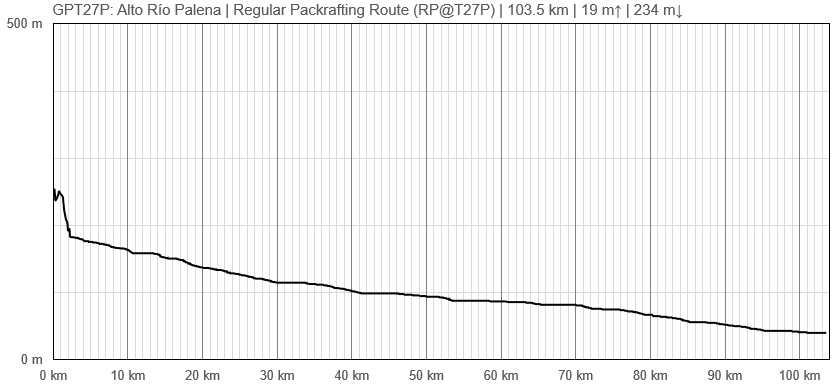GPT27P - Alto Río Palena
|
|
| |||||||||||||||||||||||||||||||||||||||||||||||||||||
Section Statistics
Basic statistics
| Traversable | Nov - May (Conditionally: Sep, Oct) | |
| Packraft | Required (101.3 km | 101.3 % on Water) | |
| Hiking | Packrafting | |
| Attraction | No Rating | 5 / 5 |
| Difficulty | No Rating | 4 / 5 |
| Distance | - | 103.5 km | 21 h |
| Direction | None | Only ↓ |
| Comment | Hiking: Packraft required | |
| Status | Published and Verified | |
| Zone | F: Zona Palena | |
| Region | Chile: Los Lagos (X) & Aysén (XI) | |
| Start | Palena , (Río Palena, Confluencia Rio Tranquilo) | |
| Finish | Río Palena, La Junta | |
| Previous Section | Next Section | Alternative Section |
| GPT26 or GPT72P | GPT28P or GPT30P | GPT27H |
Section Planning Status
Recommended Travel Period
Benefits of Hiking and Packrafting
Recommended Travel Direction
Section Length and Travel Duration
Section Attractiveness
Section Difficulty
Resupply
Resupply Towns at Start, Finish and off Route
Resupply en Route
Access to Route
Permits, Entry Fees, Right-of-Way Issues
Regular Route
Regular Hiking Route
Elevation Profile of Regular Hiking Route
|frame|center|Elevation Profile of Regular Hiking Route (2019)]]
Comments to Regular Hiking Route
Regular Packrafting Route
Elevation Profile of Regular Packrafting Route
Comments to Regular Packrafting Route
Summarising route description to be issued.
Route description by Kara Davis after Season 2017/18:
Notes to consider before beginning: Be aware that the Chilean border control outside of Carrenleufú requires you to declare items in your possession, so keep this in mind when resupplying. They will confiscate certain foods, including produce and honey brought from Argentina.
This is the first time during this hike where the Regular Hiking and Regular Packrafting Routes begin to significantly differ. The two tracks do not rejoin until GPT32.
Beginning from Palena, walk north down the paved road, 235-CH and cross Puente Palena to the put-in on the western bank of Río Palena. The river is swift and has several Class I and Class II rapids. There are also many places where the river splits and becomes very shallow. I would recommend scouting any rapid that makes you uncomfortable. Also be wary of obstructions, such as logs and branches, that occasionally block parts of the river. Camping along the edge during this stretch of the Río Palena is difficult due to the thick foliage and steep rocky beaches. Flat and clear spots are a rare find.
The river widens out approximately 12 km from the Palena put-in. There are still several class I and class II rapids, but with longer stretches of flat water in between. The banks on both sides are littered with rocky beaches, and nice camping is still hard to come by. There is also a notable increase in the density of homes and other structures lining the river.
The banks of the Río Palena flatten out and provide better camping after the ferry at El Tranquilo, approximately 20 km from put-in. This car/passenger ferry draws itself across the river along thick metal cables which can be easily passed on a packraft. A lot of the surrounding land is used for grazing and traces of livestock are everywhere. A sign advertising a refugio, “Predio El Refugio,” was located at La Mula, approximately 12.5 km past the ferry crossing. As several smaller streams join the Río Palena, the river swells and the frequency of rapids decreases.
The river continues winding through farmland all the way to the La Junta take-out. There is a small beach here with a trail that leads up to Highway 7. La Junta is located about 2 km south of the take-out.
Town: La Junta
In La Junta, there are plenty of lodging options, from hotels and cabañas to camping, as well as a couple medium sized grocery stores adequate for resupply. There is a tourist information center located at the edge of the main plaza.






